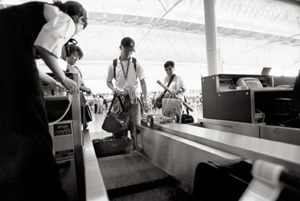 Formerly a sub-division in the Municipal Sector Division, this division was formed in June
1998 to provide engineering services to the Airport Authority Hong Kong (AA) and the more
than ten government departments based at the Hong Kong International Airport. With an
on-site team of over 400 staff, the division provides operation and maintenance services
for key AA plants such as airfield installations and systems; air-conditioning, electrical
installations and pumping systems in the various buildings, as well as the baggage
handling system. Most contracts with the AA are the result of this division winning
several competitive tenders. At the airport, the team also provides maintenance services
to Hongkong Post's postal mechanisation system at the new Air Mail Centre, trunk mobile
radio handsets for the police, and a specialised E&M system at the Government Flying
Service's new headquarters.
Formerly a sub-division in the Municipal Sector Division, this division was formed in June
1998 to provide engineering services to the Airport Authority Hong Kong (AA) and the more
than ten government departments based at the Hong Kong International Airport. With an
on-site team of over 400 staff, the division provides operation and maintenance services
for key AA plants such as airfield installations and systems; air-conditioning, electrical
installations and pumping systems in the various buildings, as well as the baggage
handling system. Most contracts with the AA are the result of this division winning
several competitive tenders. At the airport, the team also provides maintenance services
to Hongkong Post's postal mechanisation system at the new Air Mail Centre, trunk mobile
radio handsets for the police, and a specialised E&M system at the Government Flying
Service's new headquarters.
 Staff have been able to tackle a wide range of engineering issues at the new airport. One
example is the modification of merge belts in the baggage handling system. Within the
first two months of the airport's operation, one third of these belts were torn and had to
be replaced. This was due to a special end pulley arrangement that often tore padlocks
from bags being carried along the delivery conveyor. When the padlocks got jammed, their
sharp metal corners tore the merge belts apart. Drawing on past experience from Kai Tak,
the team immediately proposed modification to raise the front head of the merge belt by
50mm at the merging joint. The results were excellent: there was no more padlock related
damage to the belts. The modest cost of the modification saved the client potential belt
replacement costs of approximately $1 million a year.
Staff have been able to tackle a wide range of engineering issues at the new airport. One
example is the modification of merge belts in the baggage handling system. Within the
first two months of the airport's operation, one third of these belts were torn and had to
be replaced. This was due to a special end pulley arrangement that often tore padlocks
from bags being carried along the delivery conveyor. When the padlocks got jammed, their
sharp metal corners tore the merge belts apart. Drawing on past experience from Kai Tak,
the team immediately proposed modification to raise the front head of the merge belt by
50mm at the merging joint. The results were excellent: there was no more padlock related
damage to the belts. The modest cost of the modification saved the client potential belt
replacement costs of approximately $1 million a year.
 Y2K compliance is of vital importance to every operation in the airport. The division has
seconded a team of engineers to provide Y2K engineering support services to the AA. It has
also helped other clients located at the airport conduct walk-through inspections of
embedded systems, supervised contractors' tests, and helped prepare contingency plans.
Y2K compliance is of vital importance to every operation in the airport. The division has
seconded a team of engineers to provide Y2K engineering support services to the AA. It has
also helped other clients located at the airport conduct walk-through inspections of
embedded systems, supervised contractors' tests, and helped prepare contingency plans.
To streamline processes, the division sought customer input through formal business improvement teams and various informal channels. One significant achievement has been the reduction of fault response times from an hour to less than 15 minutes, as a result of implementing customer recommendations.
Business prospects are positive. At the time of writing, the division had won five additional competitive tenders to maintain the aerobridges, X-ray baggage and passenger inspection equipment. Opportunities for growth are excellent as the aviation industry in the region continues to develop and prosper.


